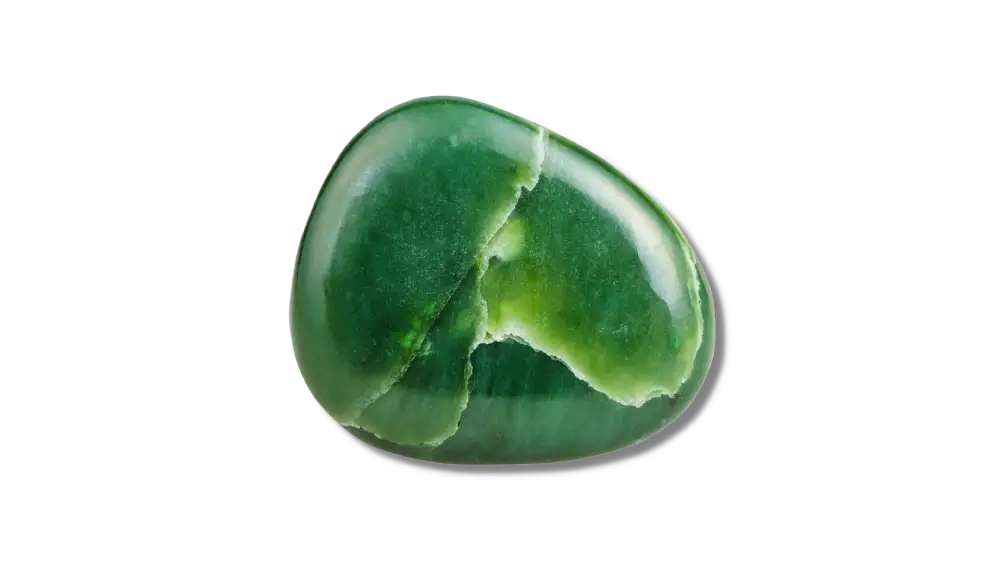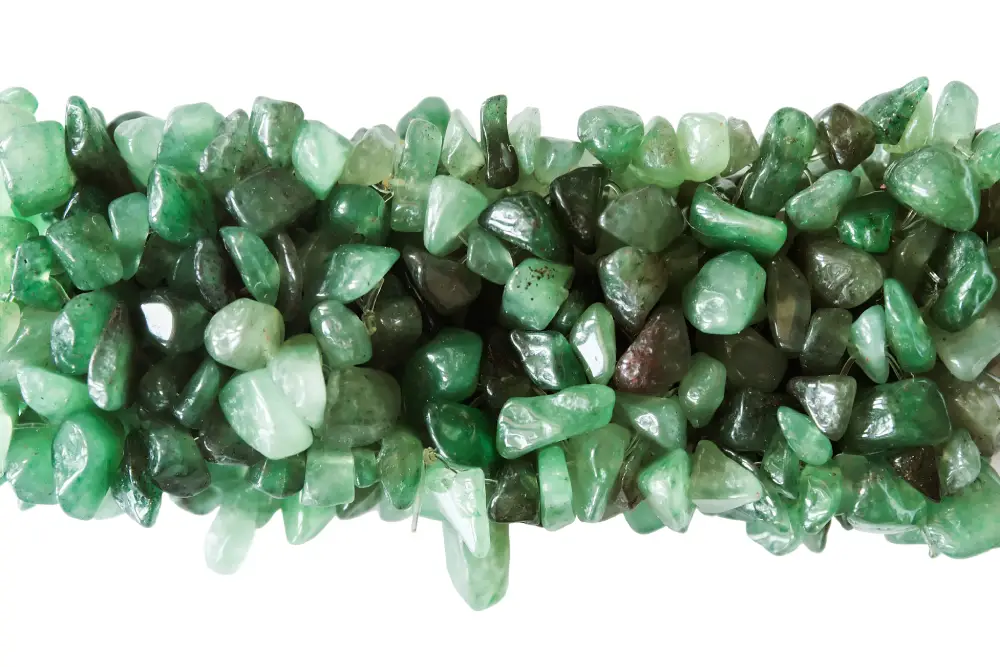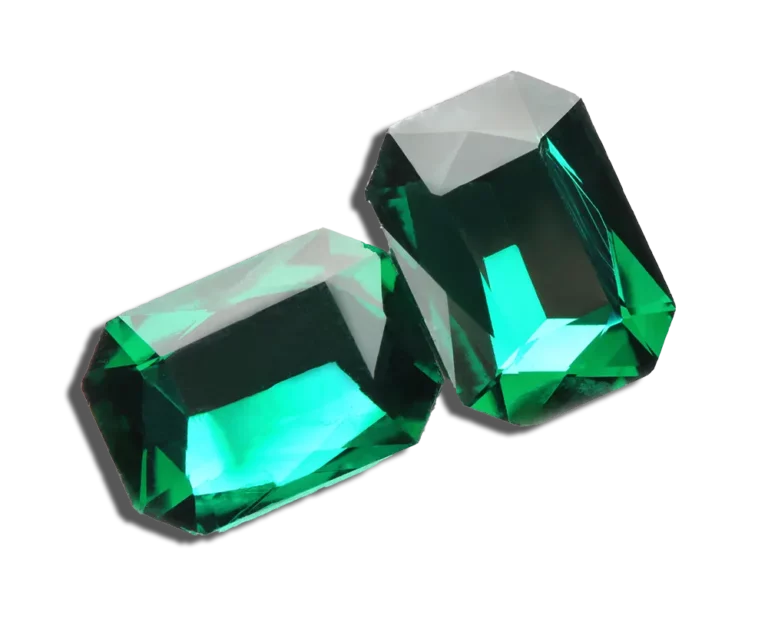Nephrite Stone: Properties, Benefits & Meanings

Nephrite Stone Overview
Nephrite stone is a green gemstone that has been used for thousands of years and is still popular today. It’s one of the two types of jade (the other is jadeite), and it’s found in only a few places on Earth, including Russia, China, Australia, and New Zealand.
It is the centerpiece of many traditional Asian homes and comes in a beautiful dark green color. This article will take a look into the properties, meanings, and uses of the Nephrite stone.
What Is A Nephrite?
Nephrite is a beautiful green stone with great historical significance. It is especially prevalent in eastern culture. This powerful stone is related to the heart chakra and is used to symbolize good luck.
Chinese believe it has many supernatural powers, including healing capabilities which is why they use it in various traditional medicines. Additionally, they also use it to ward off evil spirits.
It is a mineral that is usually green but can be found in white. It’s found in Japan, China, and New Zealand. It is a hard and translucent mineral that has a dull luster.
Nephrite stone is a green form of amphibole, a group of minerals that includes actinolite and tremolite.
It’s also known as the “microcrystalline” variety of the amphibole group, making it a jade form. As a member of the amphibole group, Nephrite has a crystal structure consisting of two types of molecules arranged in sheets. These sheets are held together by intermolecular forces.
The most common sources of nephrites are usually greenstone or serpentine, but they can also be found in other minerals such as chalcedony and jadeite.
Etymology
The name Nephrite comes from the Greek word nêphros (kidney) and the Greek adjective lithos (stone), which means “kidney stone”. It refers to how this particular type of rock looks when cut or sliced.
Nephrite Stone Appearance
Nephrite, a type of jade, is a semi-translucent, greenish-brown mineral that can be either translucent or opaque. It’s traditionally cut into cabochons to showcase its beautiful range of colors—from creamy white to deep green. The stone has a beautiful green color with white patterns running through it. The patterns resemble fish scales or a tree bark texture.
In terms of appearance, this stone is very similar to jadeite and tremolite. All three are forms of the same mineral, but their chemical composition and crystal structure distinguish them.
This mineral is also known as “mutton fat” because its soft texture makes it look like mutton fat when it’s polished.
History of Nephrite
Nephrite was used as a gemstone by many cultures.
Paleolithic Era
Nephrite is a mineral used in jewelry since the Paleolithic era. It is believed to be named after the Greek god of the sea, Neptune, because of its green color and resemblance to other green gems like emeralds and peridot.
This stone was used by the ancient Egyptians and Mesopotamians, who valued its hardness, durability, and ability to resist temperature changes.
China
Nephrite is a type of jade, a type of gemstone. Nephrite stone can be found worldwide, but the most popular locations include China and New Zealand.
This mineral was first discovered in China around 4,000 BCE by the Chinese, who used it to make tools and weapons. Additionally, it was used as an ingredient in some traditional Chinese medicines because they believed it had healing properties.
In China, it was used as an ornamental stone in buildings because they thought it could ward off evil spirits. Nephrite stone has also been used in architecture in other parts of the world: there are statues made out of this stone that date back more than 2,500 years!
Over time, Nephrite stone became popular around the world as an ornamental stone due to its beautiful green color and hardness (7-7.5 on the Mohs scale). This makes it ideal for use in jewelry such as rings, bracelets, necklaces, and other things such as sculptures or statues.
However, it can be challenging to work with due to its hardness, so you’ll need some good tools if you want to carve something without breaking your blade!
Nephrite stone was used as a gemstone by many cultures, but it wasn’t until ancient China that people started carving it into works of art. It was thought to have healing powers in China—it was used to reduce fevers and ease the pain. It’s also believed that Nephrite would help you stay calm during times of stress or anger.
In the 20th century, the Chinese regime considered it illegal to export fine jade out of the country.
Japan
Nephrite has been used in Japan for centuries, dating back to the Jomon period (14,000 – 300 BC).
It is a rare mineral used to make tools and weapons in ancient Japan. It was also used to make jewelry, such as necklaces and earrings.
Many different cultures around the world use Nephrite stones for many various reasons. In Japan, it was used as currency until 1873, when they started using paper money instead.
The Japanese believed this gem could be used in rituals to protect them from evil spirits and bad luck. They also believed that wearing Nephrite jewelry would protect them from becoming ill or dying prematurely. They thought that if they were buried with their jewelry, they could be reincarnated after death and live forever!
Europe
Nephrite stone has been found in Neolithic and Chalcolithic Europe. It is a stone used for thousands of years in Europe, particularly in the Balkans.
The Nephrite culture of the Balkans refers to the period of time from 500 B.C. to 1000 A.D., when this gem was used as an ornamental and decorative stone.
Nephrite from Europe has been discovered at many archaeological sites throughout the region dating back as far as 4000 B.C., including those at Uluburun (Turkey), Troy VI (Turkey), Knossos (Greece), and Mycenaean tombs (Greece).
Maori
The Maori people of New Zealand used Nephrite to make tools, weapons, and jewelry. The Maori named the stone “pounamu,” which means “greenstone.” They believed that pounamu was a gift from their god Tane, who created the rock with his own hands.
Where Can You Find Nephrite?
Nephrite stone is found in metamorphic rocks, which are rocks that have been changed by heat and pressure to form new minerals. It is found in the following countries:

How Is It Formed?
Nephrite stone is a metamorphic mineral, meaning changes in temperature and pressure form it. This stone is a type of jadeite, a hard rock that forms when metamorphosed sedimentary deposits are compressed into mafic igneous rocks.
Nephrite can be found in metamorphic and igneous rocks, but it’s most commonly found in metamorphosed limestone.
How To Tell If A Nephrite Is Genuine?
Here are a few simple tests that will help determine the authenticity of your stone.
Scratch Test: Nephrite has a hardness of 6-7 and can’t be scratched by glass. However, it may be marked by steel. So If you can scratch it with a knife and not with glass, your stone is probably genuine.
Acetone Test: Put a drop of acetone on the stone and see if the color changes or fades. If the acetone has no effect, then the stone may be real.
Check its Weight: Nephrite is a dense stone. It should feel heavy when you hold it.
Nephrite vs. Jadite
Nephrite and jadeite are two types of jade. While both are composed of calcium (ca) and magnesium (mg), they differ in their molecular structure.
Nephrite is a metamorphic mineral that forms under high pressure and temperature. Jadite is an igneous rock that forms from the cooling of magma or lava.
Jadeite is harder than Nephrite. In addition, Nephrite’s color ranges from pale green or white with darker streaks, while jadeite is usually either light gray to dark green (or even black).
Nephrite is a mineral that is made up of calcium-magnesium silicate. It is sometimes referred to as “soft jade”. It has colors ranging from white to green.
Its hardness is about 6.5 on the Mohs scale, which means it is harder than talc but softer than quartz. Nephrite stone can be found worldwide, including in China, New Zealand, Canada, Brazil, Japan, and the United States (Maine).
Nephrite stone has been used for centuries by artists as a carving material because of its toughness and ability to hold an edge when carved into shape.
Jadeite is also a mineral made up of calcium magnesium silicate; however, it has a slightly different chemical composition than Nephrite, making it harder and denser (7-7.5 on the Mohs scale).
Jadeite also contains small amounts of iron oxide, making it green or bluish-green when appropriately polished by an experienced lapidary artist. It can be found in many places worldwide, including China, Myanmar (Burma), Guatemala, and Russia (Yakutia).
It has a higher density than Nephrite, making it more valuable because it takes longer for them to break down into dust.
Jadeite (also called “true” jade) was first discovered in China during the 17th century. It was used as an alternative to green jade until 1866, when it became clear that there were two types of jade: one called Nephrite (which is white or green) and one named jadeite (which has a gray color).
Physical Properties
Nephrite is a type of jade that has a translucent, greasy luster. It also has a conchoidal fracture (a breakage pattern that looks like the inside of a shell or conch) and hardness (6-7 on the Mohs hardness scale).
It is a silicate mineral, a variety of the amphibole group with chemical composition: Ca(MgFe)Si[O]·5(H2O). It is an essential rock-forming mineral found as fibrous veins in mafic igneous rocks.
Nephrite jade is one of two distinct types of jade, the other being jadeite (which is much rarer and more valuable).
This gem’s hardness ranges from 6 to 6.5 on the Mohs scale; it has a conchoidal fracture and a greasy luster. Its specific gravity ranges from 2.5 to 2.7.
It occurs as fibrous masses or compact crusts in pegmatites or gneisses, sometimes associated with quartz and feldspathoids such as albite or oligoclase; also found in metamorphosed travertines near hot springs.
| Mineral Group | Amphibole Group |
| Formula | Ca2(Mg,Fe)5Si8O22(OH)2 |
| Color | Light to dark Green, |
| Hardness (Mohs scale) | 6 – 6.5 |
| Refractive Index | 1.606 – 1.632 |
| Fracture | Conchoidal |
| Luster | Dull |
| Specific Gravity | 2.95 |
| Transparency | Translucent to Opaque |

Price & Value
The best Nephrite stone is found in China and Japan, and it’s considered a national treasure by both countries. This gem’s value can range from $120 to $1000 per carat, depending on its size, quality, color, and cut.
Size: Small stones tend to be less valuable than large stones.
Quality: The quality of Nephrite is determined by how much iron it contains. Iron gives the stone its green color. Stones with more iron will generally be darker than those with less iron or none.
Deep green Nephrite is more valuable than brown or yellow. High-quality Nephrite stone has no visible flaws.
Cut: This gem can be cut into cabochons or free-form shapes such as spheres or ovals. A well-cut stone will bring in more money than a poorly-cut stone.

Chakra Connection
The Root Chakra is considered the foundation of all energy in our bodies. It represents our survival instincts, security needs, and sense of belonging.
The root chakra is associated with the color red, which symbolizes the physical body and our connection to the Earth’s energies below us.
Nephrite crystals have an abundance of green energy combined with red, making them excellent stones to help balance your root chakra if you are experiencing any imbalances related to either one or both types of energies listed above.
Nephrite is a stone that will allow you to feel grounded while helping you release any negative emotions or thoughts.
Metaphysical Properties
Nephrite, a stone of the heart, is known to be a stone of healing and protection, bringing balance to the body and mind. Nephrite stone is also considered an excellent grounding stone that helps one to stay in the present moment.
It is believed to help one deal with grief, stress, and anxiety. It is also said to have healing properties for the kidneys, adrenals, and spleen.
It is also known as a stone of self-control and balance, helping you to stay centered and calm.
It can help you find peace with your past to move forward into a new life. These crystals can also help connect you with your inner power so that you can take control of your own destiny and create the life of your dreams.
It helps to calm the mind, which can be helpful in times of stress and anxiety.
Additionally, this crystal is thought to bring peace and balance to romantic and professional relationships. It can help you find common ground with others, even if you’re at odds with them.
Nephrite stone is also said to be helpful for those trying to make their mark in the world and who need a little extra push in the right direction.
This stone may help bring people together so they can work together towards a common goal or purpose.
It encourages teamwork and collaboration and can help people find their place in the world where they may feel like outsiders or misfits.
Meaning And Uses
- Nephrite is a mineral with many uses, such as being used in making Japanese knives.
- This gem has been used to make jewelry, sculptures, amulets and other artworks since the Neolithic period (about 5000 BC).
- Many cultures have also used it as a gemstone for thousands of years.
- It’s often used as a decorative stone because of its gorgeous color, and it can also be used in industrial settings to make things like ceramic and porcelain.
- It’s also commonly used in architecture, sculpture, and other types of artwork.
- Nephrite stone is also used to manufacture kitchenware, tiles, and other decorative items.
- It is a stone of balance and harmony. It helps to balance emotions, bringing calmness and peace.
- It is a stone of good luck, bringing prosperity and abundance.
- Nephrite is a protective stone, keeping you safe from harm.
- Nephrite jewelry, such as pendants, is often used to help with fertility issues and ease pain in joints associated with arthritis or other conditions like fibromyalgia.
- This jewelry can be worn by men and women because it does not discriminate based on gender!

How To Take Care Of Nephrite?
Here are some tips on how to clean your Nephrite jewelry:
- Use a soft cloth or brush and gentle soap or water to clean your jewelry gently. You can also use a toothbrush if needed.
- For extra shine, after cleaning with soap or water, buff your jewelry with a soft cloth or brush until it’s completely dry again (this step is optional).
- Please store your jewelry in an airtight container or pouch when not being worn so that dust does not settle on it
- Avoid using chemical cleaning products like bleach as they can damage the stone.
- It’s also important to avoid ultrasonic cleaners, soaking in water for too long, and heat—especially steamers. Steamers will cause the gem to expand, affecting its shape or size.
FAQ
Which Gemstones Go Best With Nephrite?
A good match with Nephrite stone is turquoise, which has a similar color and texture. The two can be combined to make beautiful jewelry pieces with bold and subtle accents.
Another stone that goes well with Nephrite is the moonstone. This gemstone has an iridescent sheen that makes it stand out from other stones when paired with Nephrite’s bright green coloration. These two stones also look great together because they complement each other’s colors so well: the deep green of Nephrite complements the light blue-green tones of moonstone perfectly.
Which Birthstone Is Nephrite?
Nephrite is not a birthstone.
It’s a type of jade that comes in various colors and has been used for jewelry and other decorative items throughout history.
How do you charge a nephrite?
The best way to charge your Nephrite is by using a quartz crystal. Quartz crystals can absorb energy from the sun and transfer it to your stone. To do this, take your quartz crystal outside into direct sunlight for at least 30 minutes. The longer you leave it in the sun, the more charged your Nephrite will be (but don’t leave it out for too long!). After bringing it inside, place your stone on top of your quartz crystal for about 10 minutes so that it can absorb some of that energy.
Is Nephrite Rare?
Nephrite stone is not as rare as some gemstones, but it’s pretty hard to come by. There are only a few places in the world where it can be found, and it’s usually only found in small amounts.






